I had planned to do to a week-long trip in mid August, but I had been going back and forth a lot about where to go – hiking in Hardagervidda or canoeing in or near Femundsmarka.
Eventually I decided to do a week long paddling trip on Isteren, a lake near Femundsmarka National Park in Norway. My plan was to park at Glotbergen, in the southern end of the lake, and then paddle north and just see where I’d end up, without any specific goals.
Day 1 – Saturday
On Friday evening I packed everything after I got off from work. I packed all the gear in my backpack, and had a separate heavy duty drybag for my food. Since I was going canoe camping, I had a lot of heavier foods, like portion packed orange juice boxes, canned chicken etc.
Earlier that week I had also purchased a Bergans Ally canoe. A foldable canoe that fits in the trunk of a car, and is made of a frame of aluminum stays, covered with a durable rubber hull. I had made a test set-up in the backyard, but I hadn’t paddled it yet.
Glotbergen was a 700km drive from home, so I wanted to start early. I set my alarm clock to 03.45, and by 04.05 I was on my way. This would be my first longer canoe camping trip, and my first week long trip alone. I was excited.
I arrived at Glotbergen at 13.00, where I paid for parking and for a one week fishing permit. The drive up to Glotbergen was pretty dull, and I can’t wait for self driving cars to be the standard.
I assembled the canoe in 30 minutes. The first time I had tried it, it had taken over an hour. I loaded the canoe with the gear in the front, strapped it to the canoe, and set off. I was finally on my way.

Water levels where low, and I soon hit a rock with the canoe. I could see traces of aluminum on the rock, which showed that I wasn’t the first one hitting the rock. This would be something I would see on rocks for the rest of the week.
Since I had been up very early, and hadn’t gotten much sleep the night before, I decided to set up camp as soon as I found a nice spot. I paddled for 1,5km when I spotted a nice sandy beach, where I landed the canoe. There where traces of camp fires and make shift fire rings all over the place. For now there was a fire ban, but fortunately, that didn’t include camp stoves.

I hiked away from the beach, and found a nice place to set up my tent. I carried my gear and the canoe there, at set up camp. The rain came soon after I had my tent up and I laid in the tent, listening to the sound of the raindrops hitting the fly. The rain soon stopped though and the clouds scattered, and the rest of the evening I tried fishing for a while, and just relaxed in camp. I went to bed early, happy to be out in the wild.
Day 2 – Sunday
When I woke up, the weather was worse than the day before. Skies where gray, and it was windy. The weather report showed winds of up to 7 mps, and of course it was head wind. My goal was to paddle to Steinsundsholmene, a group of small islands, a mere 3 km north of my camp, and after breakfast I set off.
Initially I had loved the portability and pack-ability of the canoe. The low water levels meant that most shores where covered with large sharp boulders, and the canoe had to be carried up on land so that the waves wouldn’t bash the canoe against the rocks. But now I learned about the downsides of this type of canoe. The softness of the hull makes it pretty slow in the water, and the light weight and construction makes it float very high up in the water. This makes it easy for the wind to grab a hold of it, to turn it around. Every gust tried to swing the canoe around, and I had to struggle like crazy just to keep is straight in the water. It was a really slow going, and I got in a pretty bad mood, and cursed my decision to buy it.
Eventually I gave up, took it to shore and decided to portage it north instead. But this proved to be difficult too, as the terrain of large boulders made it hard to pass with the canoe. I sat on a cape for a while, reviewing my options, and wondered why the hell I hadn’t gone hiking in Hardangervidda instead. I decided to put the canoe back in the water and just paddle like a maniac.
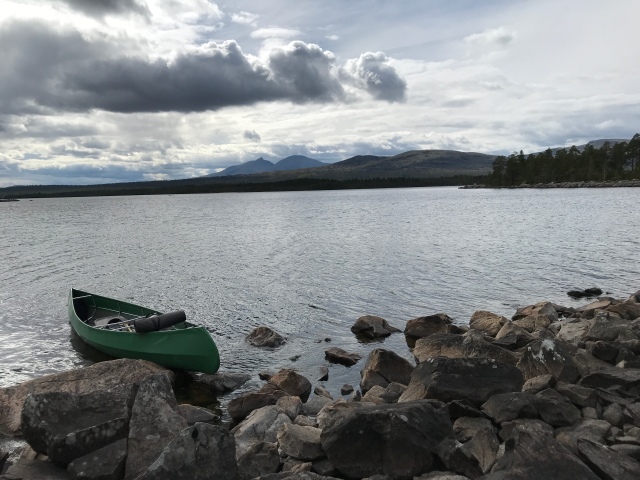
I eventually reached the islands, and set up camp on a cape in the mainland. I wanted to hike up to the nearby mountaintop Bottölen the next day.
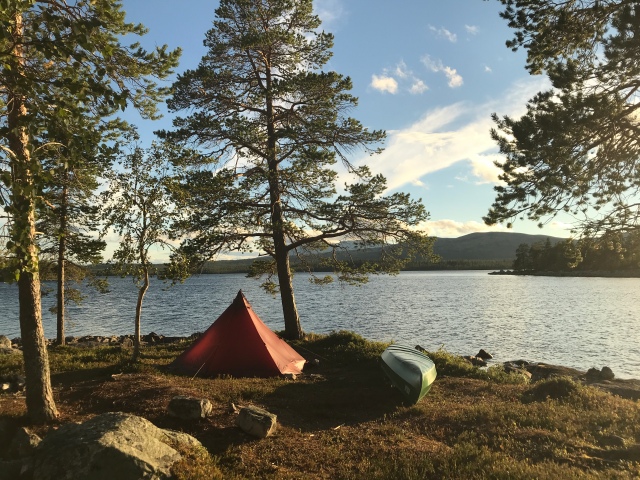
The campsite was beautiful, and had a great place for my tent. I fished for a while, and soon a big perch bit my little spinner. I’m not really a fisher man, so it was the biggest perch I had ever caught (which doesn’t say much really). As soon as I got it close to shore it got off my hook though, and swam away.

The winds had calmed down and the clouds had scettered, and by the evening the weather was really beautiful. I put the canoe back in the water and paddled around for a while. Paddling in calm waters is really nice and relaxing, and now I was glad to have chosen a canoe camping trip. I put my hammock up, and had a nice calm evening.
Day 3 – Monday
I had decided to stay two nights at my campsite, since it was a great location, and also because I wanted to do a day hike to the nearest mountain top – Bottölen. Bottölen is only 905 meters above sea level, but it’s still above the treeline.
After having breakfast I packed my backpack with food, water and cooking utensils, took my map, set a course on my compass and headed out. Just as I left three canoes full of people passed my camp.
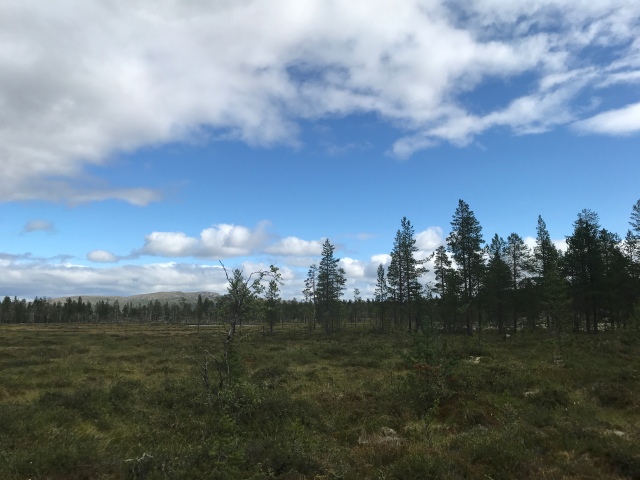

I bushwhacked through the forest in a steady uphill. The top was only a little more than 2km from camp, but it was still enough for me to break out a sweat. There was a small mire between my camp and the top, and I hiked south of it, to avoid getting my feet wet.

Soon enough I reached the treeline, and despite the pretty low altitude, I had a nice view over the surrounding area. I kept hiking up, and eventually reached the top. The view was great, but I had to change my plans about dinner on the top. The winds blew too hard, so after a few photos and admiring the view, I started to hike back down, to make lunch at a more sheltered place. I had lunch at the mountain side, and then continued back to my camp.

The rest of the day I just relaxed in camp, hung out in the hammock, fished and paddled around the area. Paddling the canoe in calm waters is really nice. The campsite was great, and I really enjoyed staying there.
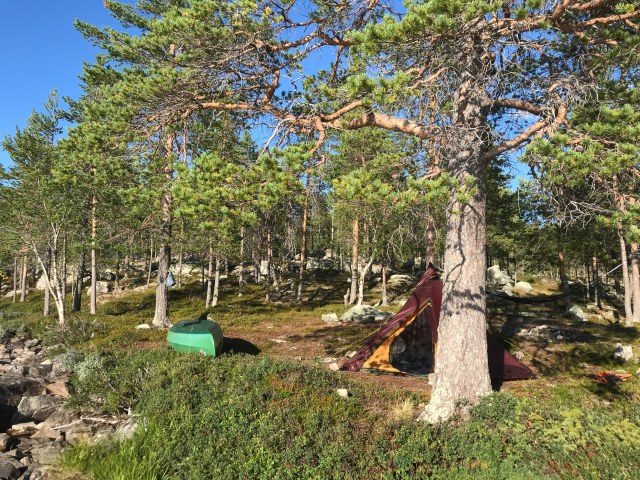
Day 4 – Tuesday
The next day I had decided to keep paddling north. I didn’t have any specific goal in mind, but more or less planned to paddle until I found a nice place and then stay there. There where almost no wind when I set out, and the lake was still as a black mirror. It was a really nice way to start the morning. I paddled slowly north, and really enjoyed the morning. After a while I stopped at a cove, heated up some water and washed my t-shirt and underwear in a zip-lock bag, before I continued again.

I reached Nysandvika, where there were a lot of tents and canoes. I saw a family take down two HMG Ultamids. It was the first time I’ve seen anyone else use cottage gear in real life.
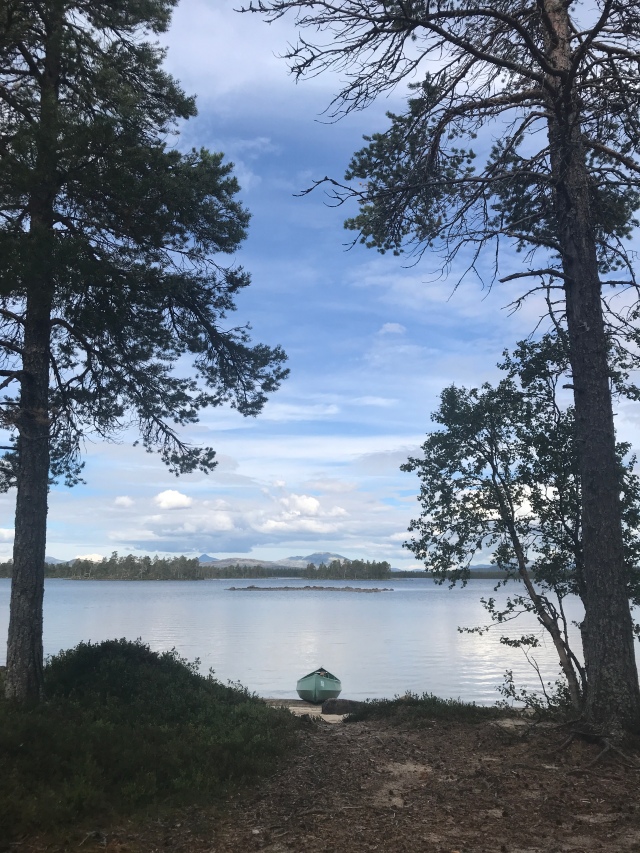
I paddled around the cape and then came ashore at the northern side of Nysandvika. The cape had beautiful beaches with white sand, but the water was cold. I took a short break, had some coffee and then set off again.
I followed the shoreline up to the cove Langvika, where I stopped again at a small beach. There where a small hut nearby, and no place for a tent, so after reviewing the map a bit I continued. I had decided to explore the island just west of Langvika and check for descent camp sites.
I paddled to the westernmost side if the island, and found a great place for my tent. It was only 14.00, but I decided to stay there. Signs of previous campers where everywhere around that part of the island. This was great, and I decided that I would stay here for two nights. I had my camp, and my hammock up, and explored the rest of the island on foot.

The island wasn’t large, but on western side there where good places for tents on both the northern and the southern end. There where fire rings on both sides, and flat grounds for tents. The rest of the island was covered in blueberry- and lingonberry bushes. It had been a great day of paddling with perfect weather, and the little over 5 km of paddling had been easy.
Day 5 – Wednesday
I had planned to keep my camp on the island, and then paddle north with just my food and cooking utensils this day. But I woke up to a windy cloudy day. I paddled almost 1 km north in the morning, just to try the waters, and had a hard time paddling back to the island. I decided to stay there instead, reading, watching Netflix and foraging.
I filled my foldable Kuksa with lingonberries and blueberries, and then went to the shore to do some fishing. I had tried to catch a fish now and then during the entire trip, but it’s not such a big interest of mine. But now I got one, after just a few throws. It was another perch, and the largest one I’ve seen. I was happy to have caught one, since I was really looking forward to spice up the diet with some fresh fish.

I filed it on a rock and then fried it in tons of butter and olive oil, sprinkled with citrus pepper. It tasted great, and I had the cup of blueberries and lingonberries as desert.

The rest of the day carried on in a slow manner. Rain came and went, and I spent most of the time reading the book “Idag ska vi inte dö” (We shall not die today), a documentary about the journalist Magnus Falkehed and photographer Niclas Hammarström who got kidnapped in Syria in 2013. The whole trip was just loosely planned, and I liked the calm serenity of camp life.
I went through my plans for the end of the trip. I was going to paddle back to my first campsite, 1 km from the parking lot on Thursday, and then paddle the last stretch on Friday morning. The weather report didn’t look too good though, as the winds for the rest of the week where supposed to be headwinds of 7-10 meters per second (15-22 mph).
Day 6 – Thursday
I woke up on Thursday morning, and just as the weather report had said, the wind blew hard. I knew I would have a hard day of paddling ahead of me. 7km in hard head wind. I had planned a route where I would paddle from island to island, cape to cape, to get protection from the winds and a chance for some rest. Just 30 seconds of rest in the open water could mean being pushed back really far.
I left the island and paddled alongside it, protected from the winds. But as soon as I left it for open waters the struggle was on. The waves had white foam on them, and I had to work really hard to get to the closest island. Waves where up to the gunwales of the canoe, but the waves weren’t the issue. The gusts where. I had to struggle hard to keep the canoe straight. No J-stroke could compensate the wind, that felt like it came from everywhere. I had to switch sides with the paddle all the time.

I reached one of the closest islands, rested a while for it and looked towards Nysandvika, my next objective. The gusts felt like they where trying to knock me over.
I tried to paddle straight towards Nysandvika, but the wind pushed me more and more east, towards the shore. Eventually I reached Nysandvika, and landed on the northern shore. Today there was only one tent there, with two people and a canoe.
I carried my gear and the canoe over to the southern side. Waters where choppy, to say the least. I thought about calling it quits, stay there and then try to continue the next day. But the weather wasn’t going to improve, so I decided to just give it a go, and hope for the best.
I set off again, but the wind blew harder on this side of Nysandvika. I struggled a lot. On one section I could see the same rock next to me for more than 10 minutes while I paddled like crazy without going forward.
I reached Steinsundholmene where I had a short relive in the wind, before I continued. The closer I got to the beach near Sundholmen, where I would camp, the harder it was to paddle. The wind threw the canoe up against the rocky shore, and pinned it between two rocks, and the waves continued to bash it against the boulders. I kept going for little while more, but halv a km from the camp site I threw in the towel and portaged the last stretch. Winds would increase during the night, and the rain had been pouring down, so I set up the tent immediately, took out food that didn’t need any cooking and laid in my tent for the rest of the evening. There had been a lot of cursing this day, and I was really tired.

The weather report showed a break in the winds between 04.00-07.00, where winds would go down to 1-2 meters per second. I set the alarm clock to 05.00, and prepared to go to sleep early.
Day 7 – Friday
Trying to go to sleep early didn’t work. I tossed and turned throughout the night. The winds got worse, and relentlessly shocked the tent. At around 02.00 it finally calmed down. I had dozed off for about one and a half hour, but now I couldn’t get back to sleep. Eventually I gave up. I always have trouble sleeping when I’ve set the alarm clock very early, and little after 04.00 I started to pack up my gear. The canoe had been upside down, but the winds had knocked it over, and the interior was filled with water and debris.
The weather was calm, with only a slight wind. Sun wouldn’t be up until 05.20, but it was still bright enough to paddle at 04.40, when I left the beach, and my last campsite. It was nice to paddle in calm waters, with silent J-strokes and the red stripes in the horizon, showing that the sun would soon be up.

I paddled up to the parking lot, unpacked the canoe and disassembled it. A 5-point wash with wet wipes and a change of clothes, and I felt like a new man. 9 hours later I was back home.
I’ve had ups and downs this trip. It was nice to be out for a week, and not really have any plans but to just wing it. But I didn’t meet anyone for a week, and it got a bit lonely in the end.
In retrospect I don’t think I’ll do a canoe trip like this on such a large lake again. The nearby mountains and the open lake makes it very windy, and this canoe isn’t really meant for that. With the canoe a lot of nice desolate places nearby opens up too, so I can get a wilderness feel without having to drive 9 hours. Next year I’ll probably hike in the mountains instead, and do canoe trips on the smaller, narrower lakes closer to home.



That fish sure looked good! I would’ve liked to of gotten my teeth into that. Looks like that you had a great week (besides all the wind on the open waters). Thanks for sharing.
LikeLike
Yeah, I cursed the canoe and my lack of technique, but I’ve understood that those wind speeds are considered to be in the upper limit for solo paddling. When I first thought about doing the trip in Isteren I only had the heavy canoe and didn’t want to do any portages, but with this lighter canoe a trip along the small lakes north of Rogen (Start and finish at Käringsjön) would probably have been a better option, since portaging this canoe isn’t an issue.
LikeLiked by 1 person
I’d like to hike up in Rogen.
LikeLike
I’ve watched a couple of YouTube-videos and it seems great. I came back from
Isteren thinking I wouldn’t go canoe camping in the mountains again, but I think I was just doing it wrong 😅. Perhaps we could meet up sometime and do a joint trip.
LikeLiked by 1 person
Yes, I would really like that. I’ve been thinking about it for some time. We should do something in the Autumn maybe and then a longer trip next year would be super. Let’s work on it. My e-mail is brianoutdoors@icloud.com
LikeLike
That would be great. An early autumn trip, when the leaves have begun to shift color, but are still on the trees would be beautiful!
LikeLiked by 1 person
Lovely, lovely, lovely.
Once day, I would love to have such a nice canoeing experience! Also, great to see some fishing and foraging.
Very nice post, I have already read it 3 times.
LikeLiked by 1 person
We just bought an Ally canoe, and I almost regret it after having read your first part of this blog entry. We only took it out for one weekend near Kalmar on the ‘sea’. When it was windy, it was really really hard, but without the wind we really enjoyed the canoe. Just fiddled around with the weight distribution in the canoe a bit. When it was off, we just went in circles, but when we eventually got it right (sitting backwards), it went straight ahead at full speed.
Did you sell your Ally? I have seen you using another canoe in your later blog posts..
LikeLike